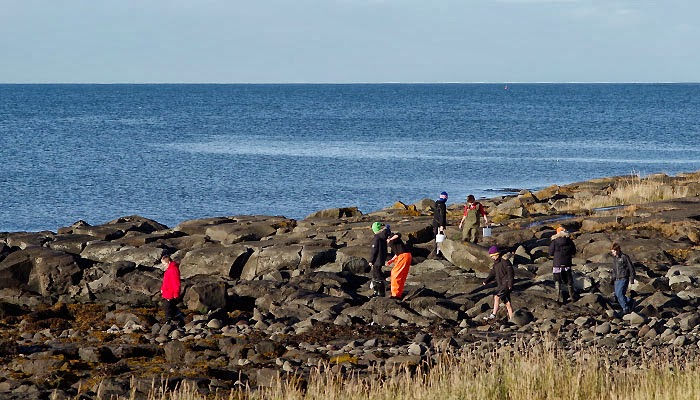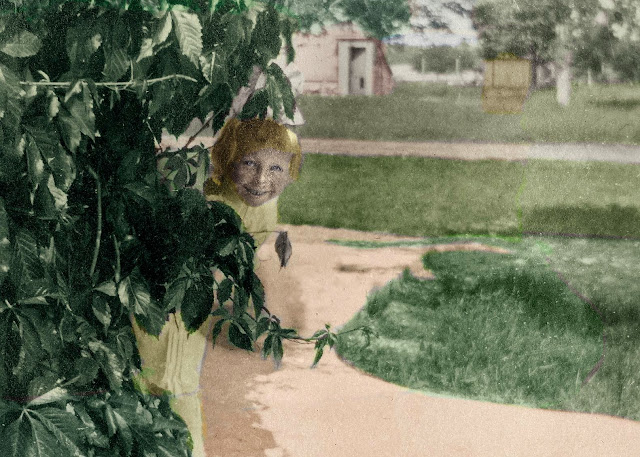Monday, September 30, 2013
Saturday, September 28, 2013
Iceland's Fall
When Autumn rolls around my thoughts turn to Iceland. I've been there in October three times, I was blessed with glorious weather each time. I've been there in March and April as well but the fall offers more in the way of cultural events. On the last visit (October 2012) I noticed that the tourist season has expanded from previous years with many more non-natives strolling the streets but nevertheless it was not really crowded. I offer you the following glimpses of Reykjavík in October—no theme; just little scenes from my memory:

Film crew, Fríkirkjan, Reykjavík, 2012
The church near where I stayed was the site of a two day film shoot, the crew had put diffusers on all the windows, then lit them so the lighting would be consistent. I spoke with one of the actors, asking if they were going to shoot all night. He said no, although I noticed that they did remain until well after dark.

School children, Seltjarnarnes, 2012
This group of teens were studying life in the tide flats. Seltjarnarnes is the peninsula area west of Reyjavík proper.

Row houses, Seltjarnarnes, 2012
The modern architecture in Iceland is somewhat severe but not, to my eye at least, unattractive.

Young people, Reykjavík, 2012
There is a secondary school in downtown Reykjavík; in the afternoon the young people flood the streets in the old town.

Street vendors, Reykjavík, 2012
Even though the temperature is usually cool (40-50 degrees Fahrenheit) there are often women knitting on the sidewalks, offering their goods for sale.
By Professor Batty
Comments: 4
Thursday, September 26, 2013
Siah Armajani

Seth and Chuck on Irene Hixon Whitney Bridge, Minneapolis, 1989
When was in art school, our normal routine was interrupted one day by the arrival of Siah Armajani, a real artist. He wasn't an imposing figure: a small, somewhat rumpled middle-aged man with a thick accent. When he spoke, however, his artistic credentials were quickly established. He was a visionary, passionate and inspirational. He was born and raised in Iran, I thought of him while reading the recent news about the possible detente between Iran and the United States. I won't hold my breath on that happening, but any progress between these two countries would be welcome. Siah is still a persona non grata in Iran.
People who go by Loring Park in Minneapolis are well acquainted with Mr. Armajani's work. He designed the bridge between the park and the Walker Sculpture Garden; it has been a landmark for decades.
By Professor Batty
Comments: 0
Wednesday, September 25, 2013
Indian Summer

Luella Busch Archives, circa 1910
Last week's cold snap was only a tease for the fall to come. For at least the next few days it will be warm and dry, as if summer had never ended. My tomatoes are thriving although the Olsons down the block have already pulled up their plants—did they think they had gone past their freshness date, or were they just sick of eating tomatoes? I'll keep mine going, several dozen green ones are on the vines. I wait until there is a freeze predicted before I harvest. The red ones we eat or put into salsa, the green ones go in a box between newspapers stored in a cool place where they will slowly ripen. I check on them every few days and toss any bad ones. A surprising percentage will survive for several weeks, one year we had tomatoes until Thanksgiving!

By Professor Batty
Comments: 4
Monday, September 23, 2013
Sunday, September 22, 2013
Cosmos

A short road trip brought the Weaver and me to the historic town of Northfield Minnesota last week. Northfield was the the last place the notorious James-Younger band ended their crime wave in 1878 when a bank robbery went wrong, leaving several people dead or in prison, with Jesse James a hunted fugitive until his murder a few years later.
But that was then, we were there to experience Mary Edna Fraser's Mapping the Planets in Silk and Sound, a collection of large scale batiks depicting various astronomical scenes. A mix of ancient and modern technology, Fraser takes NASA images and converts them into hanging tapestries for a truly ethereal exhibition. Located in the Flaten Gallery on the St. Olaf campus, the airy space (with a hurricane-like ventilation system), the show was augmented by Mark Mercury's trippy soundscapes.
Would Jesse James have approved?
By Professor Batty
Comments: 6
Friday, September 20, 2013
Alliance

The Weaver has several works featured in a fiber and fashion show held at the Arts Alliance of Elk River, Minnesota. I went to the opening and found some interesting vistas:
A shawl woven from vintage French wool:

A young student of fashion:

Amy Cunningham's outrageous Three Generations:

By Professor Batty
Comments: 0
Wednesday, September 18, 2013
Mistaken Identity

My other blog, the Laxness in Translation site, received a hit from a Goodreads review the other day. The link in the reviews comments was the the Laxness site, but it had an ".ie" suffix instead of a ".com"; the commenter said it must be located in Ireland. I checked the link myself and also tried it with other European suffixes. Sure enough, there was a French, German, and Danish version as well. Once I got to the site's homepage the site's internal links worked normally.
A little research found the answer. Apparently, Blogspot (Google) is now making country specific domains for all its sites in order to allow individual countries to shut down any potential offenders. I tried it with FITK; it worked the same way.
Who could have foreseen that my simple blog would become subject to international scrutiny?
By Professor Batty
Comments: 1
Tuesday, September 17, 2013
Dave Ray on Work

Mary Jane Mueller and Dave, Minnehaha Park, 1995
Note: This extended "rant" by the late Dave "Snaker" Ray is about his daily life and the misunderstandings people have about musicians. Dave was a celebrated blues singer and guitarist, a legendary raconteur and internet pioneer. His now defunct website was active from the mid nineties until about 2005, but is still accessible via The Wayback Machine.
This is one of several essays by Dave and was written shortly before his death in 2002.
"WHAT DO YOU DO ALL DAY?"
Guys in jackets and ties walking into the pretty blue buildings downtown never get asked what they do all day, unless it's by their wives, recalling "Angel From Montgomery," and wondering if he can be gone eight hours and have nothing to report. Guys with ladders on top of their vans and tools in the back never get asked what they do all day. People don't ask them because the assumption is there, based on the evidence of dress or implement, that these people work for a living. Most people could care less what someone else does all day, as long as it looks like what they do is productive and somehow conducive to an incremental increase in the GNP, or DNP or whatever it's called these days. Try to make a living playing the guitar, though, and people are constantly asking you: "What do you do all day?" When I try to make an appointment to meet someone in the morning, they give me the wink and say, "You mean around 3:00?" If I tell them I'm too busy to see them in the next couple of days, they start with the "What do you do all day?" I guess they figure the guitar player's life consists of rolling out around noon, kicking back in the Barca with a cold one, catching some ESPN, maybe take in a ball game, smoke a little rope, take a nap, have dinner, get driven to the gig, noodle for a couple hours, go back to chicken shack for a snack and little what-you-may-callit with the old lady and nod off around three AM. Maybe a few observers are acquainted with some of your more serious type of musicians who spend a lot of each day trying to decide which foods to eat and which pills to take to get them to just the right level of performance before they go to work that night. Most of these analysts must figure that musicians spend the whole day just thinking about their personal weltanschauung, you know, man, their space, and not much else.
I ran an insurance agency for fifteen years. Nobody ever asked me what I did all day. Nobody in their right mind would ask an insurance man what he did all day unless their Nembutal script just wasn't strong enough and they really needed some winks. I once went to the trouble of cataloging what my Finnish amanuensis and I did all day. It was 1986 and I thought we ought to automate our agency. I wanted to be able to justify the high cost of automation, so she and I kept a log for two weeks of what we did. By dint of heritage and fear of narrative, she was somewhat less than forthcoming in what she actually did all day. She had entries like: "answered the phone," "wrote checks," "filed," "had lunch," stuff like that, usually with no times attached. I put all my post-Catholic, workaholic, Germanic obsessive traits to good use by pencilling in the duration of phone calls, mileage for errands, applications filled, all the numbers any efficiency expert would love to see. When it was all over, the eighty-twenty rule was affirmed. Most of the tasks we accomplished were devoted to satisfying twenty percent of the clientele. We proceeded with automation, although it was pretty obvious the computer would never be able to do what we were doing. In those days, "paperless" was a bold dream and what the machine actually did was increase our workload by a factor of ten and nearly bankrupt our operation. By the time I sold the agency in 1996, the machine had fulfilled its Peter Principle goal of serving as an elaborate adding machine and typewriter. We still had drawers full of paper and we still had to go to the bank and we still had to use the telephone. The computer forced a certain organizational hierarchy into our thinking and our way of doing business that resulted in an unquantifiable gain in productivity but made us feel mainstream.
My point in relating this automation history is to let you know I'm no stranger to computers. If you're not either, then you know what I'm talking about when I say that any answer to the question "What do you do all day?" must include a certain allotment to the care and feeding of the computer. I can't work without a computer. When it's doing a maintenance task and I can't access it, I have nothing to do. All my work is connected to the machine: music programs for writing and recording, addresses and phone numbers, bookkeeping, this Web page, my schedule, my list of vitamins–everything. It's been a slow, inexorable process and one from which there is no return: I'm cybernetically attached, like a life-support system. When I can't use it, I have to resort to some really time-wasting, ephemeral busywork, like reading or practicing guitar, sleeping or vacuuming.
Except for major maintenance tasks, you won't see in the following logs any of the time spent in file manicuring, error analysis, software grooming, learning programs, disk defragging, reindexing and all the myriad time-consuming tasks required to keep a clean hard drive and a sporty desktop. We nerds know how long it takes, the rest of you will have to accept that what might appear as too much time allotted to certain tasks is the overhead inherent in owning the machine.
Other than computer-related busywork, my time is spent like yours: looking for meaning in life and trying to stay Two Steps Ahead Of The Blues.
By Professor Batty
Comments: 0
Monday, September 16, 2013
Obscurity

Mr. Mark and Phil Kitze, Half Time Rec, Saint Paul, Minnesota
I caught a performance of Mr. Mark (my guitar repair guru) playing in a blues/rock band last weekend. He plays bass, on upright or on a solid body electric. His bass guitar of choice is a Micro-Frets™ Signature, a very rare bird from the early 70's, probably no more than a couple hundred were made. Micro-Frets guitars had many advanced features which was probably the reason why the brand didn't survive—guitarists are a very conservative group when it comes to their instruments. There has been talk of resurrecting the company for years but with the industry in a downturn and with the world awash in cheap guitars made from standardized parts I see little chance of that happening.
Mark loves his (he has two!) and wouldn't trade them for the world.
By Professor Batty
Comments: 2
Friday, September 13, 2013
Permanence
In the last twenty years I have been slowly acquiring ceramic pieces; an accidental collection which seemed to grow of its own accord. The elegant Paul Epple raku jars flank a pair of cartoonish Listvinahúsið Viking candle holders, while beneath a flat Joan Mooney porcelain dish is paired with a family heirloom mixing bowl (circa 1920, maker unknown):

More Mooney porcelain. Beautiful and functional, these get used:

This window wall greets me as I arise every day:

A theme-less collection, I display what I enjoy, nothing here has any real monetary value.
Ceramics are one of the foundations of modern civilization, enabling humans to keep food and liquids safe from vermin and were also used as a text recording device! Of all the things I’ve posted about this week (books, photos, digital media) only these humble pots have a good chance of lasting into the next century and they are certainly the only things which could last into the next millennium. They might even survive a meteor strike (if it wasn’t a direct hit!)
By Professor Batty
Comments: 0
Wednesday, September 11, 2013
Ephemera

The Flippist Media center occupies a small corner of the living room; we keep it constrained there in order to keep the rest of the house safe from its corrupting influences. It's an odd mix of old and new technology: thrift store audio, a new LED TV and Blu-Ray, perched up an old microwave cart and flanked by homemade shelves. Few of the DVDs are new (except for the Icelandic movies—kind of hard to find them second-hand here in Minnesota).
The DVDs are a mix of genres and directors. The Coen Brothers have their own shelf, as do the Icelandic. The rest are movies which I think I'll watch again, some Kubrick, some Wes Anderson, a few Woody Allen and some musicals. I've reviewed many of them here, and I have even lent them to friends and family on occasion. In spite of the push to "the cloud" I think this form of media will be around for quite a while: they are just too cheap, available and their play-by date never expires.
TV is a whole 'nother critter. We only have broadcast, which limits our selection (which is a good thing!), but the image quality is usually higher than cable (whose interface seems stuck in the early eighties). What broadcast TV will consist of ten or twenty years from now is hard for anyone to predict, particularly if true HD quality broadband internet becomes ubiquitous and cheap. The Blu-Ray player does have internet capabilities, but is so clunky that it is never used. That situation may change, however, if the new Apple TV box coming out in November actually does integrate various content providers.
The best part of the system is the audio- DVDs generally have better sound than CDs and my old Onkyo amp with coaxial KEF speakers and the Yamaha subwoofer does a great job. No surround sound though, it gives me a headache.
Friday: Permanence
By Professor Batty
Comments: 0
Monday, September 09, 2013
Reference
It has been a while since I've posted any bookshelf pictures, so, for you “snoops” out there, here are a couple images showing the “Flippist Reference Library™”:

Top left shelf contains Icelandic music and videos, along with doubles from my Halldór Laxness collection and a few “teach yourself Icelandic” books (I DIDN'T). The shelf below has the bulk of my Icelandic literature, mostly Laxness, but also some Sjón as well as a few Faroese authors. Fun for some, not for all. Moving down to the third shelf are music related books, heavy on Dylan, with Björk and Joni Mitchell. The right side has modern authors writing about Iceland (Indriðason, Nancy Marie Brown, Bill Holm, others).

Lower still are the books on Mythology (Campbell, Graves) folktales and then a mix of old fiction, art, poetry, biography and even a family genealogy. The bottom shelf has mostly art and photography (along with my High School yearbooks!)
The shelves on the right contain my music collection, They seem empty now because I recently thinned them out and also moved my DVDs which had been there to the Flippist Home Theater Media Center™ (subject of a later post.)
I've been going through a house cleaning purge lately; I can see my possessions dwindling in the future. I don't want to leave my heirs with a bunch of meaningless stuff. The Flippist Archives are safe for now; I use them for this blog. The photos and artwork on the walls as well as my modest ceramic collection (also to be featured later) have become a surprising joy to me.
All of this Proustian reflection leads to a deeper issue: as the tenth anniversary of FITK approaches I wonder what will be the ultimate fate of this site? Discovered by new generations? Not likely. Buried in some forgotten server until a meteor blasts it out of existence? More likely. The old material here is still accessed every day by persons all around the world. The new posts are read as well by a few dozen people, some of whom I know, some I don't (here's looking at you, Pretoria!). Facebook users also link to pages, although they never leave a comment. That's OK. It's a blog of images and ideas, not a social group. If I can brighten someone's day or offer a new perspective in my blog-posts, that is enough justification for me for me to continue its existence.
Which is more than can be said of television, the subject of Wednesday’s post.
By Professor Batty
Comments: 11
Friday, September 06, 2013
How I Spent My Summer Vaction - IV

My final guitar (as if!), a bit of a Frankenstein monster, assembled from left over parts from 40 years of tinkering (and a orphan body and neck.) Not a classic, but plays well and sounds good. As far as guitars go, I'm set for life!
I'll be back next week and try to publish some more substantial posts.
By Professor Batty
Comments: 1
Wednesday, September 04, 2013
Dancing Queen

Lily, Sun Prairie Wisconsin, 2013
You are the dancing queen, young and sweet, not yet seventeen~Abba
Dancing queen, feel the beat, from the tambourine
You can dance, you can jive, having the time of your life
See that girl, watch that scene, diggin' the dancing queen…
By Professor Batty
Comments: 0
Tuesday, September 03, 2013
40 Years Ago

I was curious so I compared the names of the artists in the catalog of the 2013 Minnesota State Fair Fine Arts Exhibition to those in 1973. I found seven names listed in both. Richard Colburn, Ron Gallas, Mike Hazard, Larry (Laurence) Hofmann, Rod Massey, David Thompson and me. There were 286 artists in 1973 and 340 in 2013. Considering that at least half of the artists in 2013 weren't even born in 1973, that means that about 7 out of about 170 were "repeat offenders", not a bad percentage.
Either we've stood the test of time, or are just too stubborn to know when to quit.
By Professor Batty
Comments: 0










